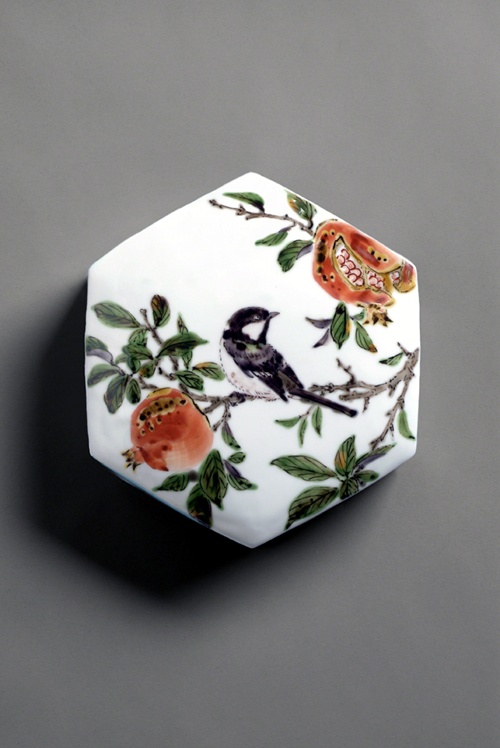International Pomegranate Month: Lu Zonggui and Keiko Mori
I can’t find anything about the history of International Pomegranate Month. However, I think pomegranate juice is yummy (and good for you), so let’s celebrate the month with art!
 |
| Lu Zonggui (active 1225–1250, China), Loquat, Grapes, and Pomegranates. Ink and colors on silk, 9 7⁄16" x 10 3⁄16" (24 x 25.8 cm). Image © 2024 Museum of Fine Arts, Boston. (MFAB-654) |
Let’s face it, the pomegranate is the star of this still life, a somewhat rare genre in Chinese painting. During China’s Song dynasty (960–1279/1280), bird-and-flower paintings evolved and the subject branched into a genre previously unknown in China: the still life. The still life genre is in keeping with the Chinese reverence for nature and the endowment of every element of the natural world with spiritual meaning. Isolated on a neutral background, this still life becomes an object for meditation. Each fruit has symbolic meaning—loquats for new life and fertility, grapes for family bonds and abundance, and pomegranates for favorable influences and fertility. Pomegranates, as well as peaches and citrus, make up the "three blessed fruits" in Buddhism.
After the fall of the Tang dynasty (618–907) in 907, China fell into a period of political turmoil. Leaders claiming to rule all of China emerged in both northern and southern China. This relatively short period from 907 to 960 is called Five Dynasties because of the rapid rise and fall of five would-be emperors in the north. It is also called the Ten Kingdoms period, because ten would-be rulers dominated different regions of southern China at the time. Finally, stability was restored when the Song dynasty was established, unifying north and south in 960 CE.
Scholars consider the Song dynasty to be one of the most significant periods of cultural and artistic development in Chinese history. It was a period of tremendous pressure and constant threat of invasion from various cultures outside of China in the north. Northern China fell to invaders who established the Jin Song Dynasty (1115–1234). After 1127, the Song ruled only south of the Yangtze River. The Song dynasty collapsed when the Mongols invaded China, first taking northern China in 1211 and ultimately defeating the Song fleet in 1279.
The major formats of Chinese painting were well-established already in the Tang dynasty through the Five Dynasties period. These were refined and expanded upon during the Song dynasty. One of the results of the Song unification of China was the creation of the Imperial Academy, which drew artists from all over China to serve the court. The early period in the 900s witnessed the rise of a great school of landscape painting that endured as the measuring stick for critics of painting in China through the early 1900s. The northern Song rulers were focused on internal rather than external matters, so the arts had a fertile period in which to thrive, especially painting. Tang realism was expanded upon and given a new monumentality in landscape, still life, and especially in genre scenes.
Southern Song painter Lu Zonggui is renowned for his paintings of fruit, bamboo, and flowers. He is also known for his ink sketches and landscapes. Born in Qiantang, he was a member of the academy of painting in Hangzhou.
 |
| Keiko Mori (born 1939, Japan), Hexagonal Box with Chickadee and Pomegranate, ca. 2001. Porcelain, 4 ¾" x 7 ⅝" (12.1 x 19.4 cm). Philadelphia Museum of Art. © 2024 Keiko Mori. (PMA-3941) |
Keiko Mori is part of a generation of contemporary ceramics artists who, although they are credited with aesthetic and technical innovation, maintain a close connection with the thousands of years of ceramic traditions in Japan. Mori fashioned this box—a form that would have traditionally been made of bamboo or lacquered wood—out of ceramic.
This particular form imitates traditional lacquered boxes decorated with floral designs seen in yamato-e painted screens, porcelain, and kimono patterns. The floral decoration also recalls the Japanese tradition of bird-and-flower pictures (kachō-ga) seen in both painted and woodblock print format. The pomegranate (zakuro) has been a symbol of abundance, prosperity, and fertility since ancient times in Japan.
The Japanese tradition of ceramics is one of the oldest on Earth. The Jōmon Culture, which flourished between 5000 BCE and 200 BCE, created the first ceramics on the planet that were decorated for decoration's sake rather than ritual purposes. Porcelain developed in Japan during the 1600s, pioneered mostly by Korean ceramic artists who had come to Japan in 1590. Influenced by Zen Buddhism, the tea ceremony (chanoyu) and flower arranging (ikebana) are cultural developments of the 1500s that brought increased respect for the ceramic arts.
In the early 1900s, a group of ceramic artists founded the Japanese Folk Art Association. They were inspired by the British Arts and Crafts Movement, reacting against the rapid "Westernization" and industrialization of Japan. This group of artists promoted the idea of the hands-on ceramic artist, one who took part in every stage of making ceramic vessels.
The need to restore a national identity after World War II (1939–1945) helped strengthen the movement to fortify traditional art forms. The reverence and respect for ceramic arts in Japan elevated the art form to the same status as painting or sculpture. Unlike their counterparts in China and Korea, individual Japanese ceramic artists have traditionally enjoyed almost star-like status. This idea has been perpetuated by government-sponsored exhibitions of ceramic art and public recognition of artists designated Living National Treasures.
Correlations to Davis programs: Explorations in Art 2E Grade 2: 3.2; Explorations in Art 2E Grade 3: 5.2; Explorations in Art 2E Grade 5: 2.1, 2.2; Explorations in Art 2E Grade 6: 1.8; Experience Art: 2.2; A Global Pursuit 2E: 5.3; A Personal Journey 2E: 5.5; Experience Clay 3E: p 145, 292

Comments